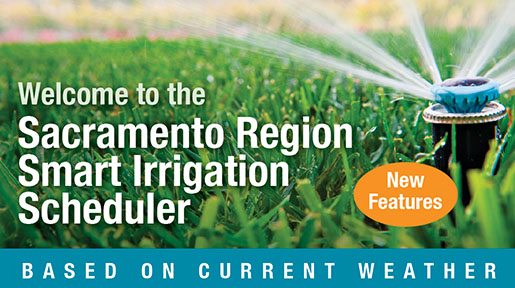By Debbie Arrington
Guest Writer
It’s time to get smart and declare your irrigation independence. Free yourself from hose dragging and watering sidewalks. Let technology help you save water, money and your lawn.
It’s time to get a smart sprinkler timer. This device allows your landscape’s irrigation system to be as efficient as possible by tuning into weather and soil conditions. It can immediately make a big difference in-home water use, as well as the health of your plants.
difference in-home water use, as well as the health of your plants.
“Really popular right now are Wi-Fi-enabled controllers,” said Don Smith, water management coordinator for the City of Folsom. “(This controller) gets weather information off the Internet. It’s also easy to adjust. It allows you to use your smartphone, computer or any enabled device to do scheduling. For the average homeowner, it has a huge impact and is great for water saving.”
Smart sprinkler timers or controllers take the guesswork out of how often to water and how much.
“We’ve found the average homeowner uses 200 to 300 percent over what their landscape actually needs,” Smith said.
Watering less often but deeper actually helps most plants, including trees, shrubs and lawns. Fruit trees that never bore fruit finally produce a crop. Shrubs and perennials flower more. Lawns look healthier.
The key to making a smart controller truly smart: Inputting correct information.
“The trick is when you first program it,” Smith said. “It will ask you a series of questions for each (irrigation) zone: What type of irrigation equipment? What type of plant material? What’s the slope? What’s the soil type? And that’s where people mess up – soil type. As long as you set the profile questions right, it will work correctly.”
(You can learn more about your soil type through the UC Davis SoilWeb—an online, interactive tool that allows you to input your address and get details about soil type. Find SoilWeb here.)
Smart controllers work well with drip systems, too, allowing for slow and deep irrigation. “Any time you can change out spray to drip, you’ll save water,” Smith said, “if used correctly. It’s a problem if run too long. Drip systems run less frequently but much longer.”
Additional resources
- Learn about rebates for WaterSense-labeled sprinkler timers
- How to Have a Smart Yard (video)
- How to Set Your Sprinkler Timer for Healthy Plants (tips and video)
- What’s the Difference Between a Weather-Based and Traditional Sprinkler Timer? (tips and video)
- Sacramento Region Smart Sprinkler Irrigation Scheduler (interactive tool)
- Smartphone-friendly Irrigation Controllers from the Irrigation Association compares smartphone-friendly sprinkler timers and includes detailed information about each controller’s capabilities and specifications.
- WaterSense Irrigation Controllers web page
- Learn How to Recycle Your Older Irrigation Controller
Debbie Arrington is a longtime home and garden reporter and author of the blog Sacramento Digs Gardening.


